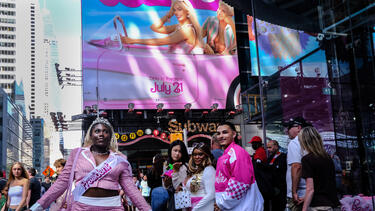The Secret of the Barbie Movie’s Marketing Success
Barbie is a genuine phenomenon, reaching $1 billion in worldwide box office in only three weeks on the strength of legions of pink-clad moviegoers. We asked Yale SOM’s Zoe Chance, a former Mattel brand manager, about the movie’s marketing and message.

Fans in New York’s Times Square for the opening of Barbie movie on July 21, 2023.
Many current TV shows and movies are reboots of existing franchises. Why has this one been so culturally omnipresent?
The marketers at Warner Bros are being touted as geniuses, credited with the blockbuster success of the Barbie movie. The movie has already grossed $1 billion in box office sales, with a marketing spend estimated at $150 million and a similar cost for the movie. It’s a great ROI but there are other important factors contributing to the movie’s success.
The real genius was the writer who understood and validated our powerful mixed feelings about Barbie. We loved her, idolized her, chopped off her hair, made fun of her, and felt a little icky about the stereotypes and gender roles she represents.
Barbie is the number-one girls’ brand in the world, and has been for most of her 50-year lifespan. When I worked as a brand manager on Barbie, we were selling a Barbie doll every second, and girls received, on average, five Barbie dolls per year. Mattel reports that more than 90% of girls own a Barbie. Their long-term marketing investment had built up a $700 million brand valuation before the movie released, and this brand has an emotional engagement that translates really well to a film. Many girls play with Barbies every day, telling stories and imagining themselves as Barbie. I can think of no other brand that approaches this level of reach and depth of engagement.
The core movie audience is anyone who used to play with Barbie—90% of women and our teenage daughters. But the real genius was the writer who understood and validated our powerful mixed feelings about Barbie. We loved her, idolized her, chopped off her hair, made fun of her, and felt a little icky about the stereotypes and gender roles she represents. The trailer promises, “If you love Barbie, this movie is for you. If you hate Barbie, this movie is for you.” The secret is that we feel both ways.
Along with the brand value and emotional engagement, the crossover adult/teen targeting made possible the biggest co-branding and licensing coup in…the history of the world, maybe? Warner Brothers and Mattel fully capitalized their crossover licensing opportunities—toys, adult fashion, car insurance, you name it. The theater where I watched the movie was promoting a Barbie-branded pink gin cocktail. (It was pretty good.) Airbnb partnered on an actual Barbie Dream House in Malibu.
Part of the appeal of partnering with Warner Bros. to promote this film was that it wasn’t already a franchise. The release of the first live-action Barbie movie marked a historic moment that would be covered in news outlets, not just entertainment media. So unlike Indiana Jones and Mission Impossible, Barbie offered a significant publicity opportunity. And who doesn’t want to make history?
Did the movie and its marketing represent something new for how Barbie presents women?
Although the film is a lot of fun, I left with mixed feelings. Mattel has always wanted moms to think of Barbie as a strong and inclusive role model, and the film reinforces those brand characteristics. But at her core, Barbie has been and will always be about materialism. She’s a fashion doll and Mattel releases a new line of Barbie products every six months that they really want you to buy. You buy Barbie new clothes, do her hair, dress her up. You play that she’s shopping with her friends. If your parents are rich, maybe she gets to live in the $179 house she dreams of. If your parents are woke, maybe she has a non-White, differently abled sidekick to go shopping with. But blonde, skinny, White, stereotypical Barbie will always be the star. Her feet will always be pointy, her waist will always be tiny, and she will always be about looking beautiful and having things. Don’t get me wrong; girls enjoy playing with Barbies this way. It’s fun. But it’s definitely not feminism.
Are there lessons for how brands can refresh other cultural products with a strong but possibly outdated image?
The Barbie one-two punch that some legacy brands could copy is to poke fun at themselves, then deliver a message that feels timely and relevant.
In the first half of the film, the audience is laughing at everything about Barbie world. Her silly feet, her airhead boyfriend Ken, his feeling so unnecessary (because he is). The filmmakers embrace the cringe, and we love them for it. After laughing at and along with Barbie, we become open-minded. Then America Ferrera nails the landing with her un-brainwashing speech, “It is literally impossible to be a woman.” We relate to everything she says. We wouldn’t have associated those ideas with Barbie (not at all!) but now we’re actually listening. Humor does that. Ferrera’s words work like a magic spell on the Barbies, waking them from the fog of patriarchy. The real magic it works is on us though, making us think Barbie might be kind of cool after all.